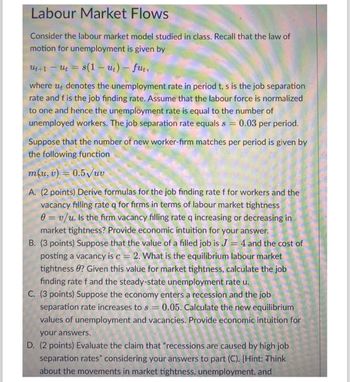Labour Market Flows Consider the labour market model studied in class. Recall that the law of motion for unemployment is given by Ut+1 − Ut = s(1 — ut) - fut, - where ut denotes the unemployment rate in period t, s is the job separation rate and f is the job finding rate. Assume that the labour force is normalized to one and hence the unemployment rate is equal to the number of unemployed workers. The job separation rate equals s = 0.03 per period. Suppose that the number of new worker-firm matches per period is given by the following function m(u, v) = 0.5√//uv A. (2 points) Derive formulas for the job finding rate f for workers and the vacancy filling rate q for firms in terms of labour market tightness 0 = v/u. Is the firm vacancy filling rate q increasing or decreasing in market tightness? Provide economic intuition for your answer. B. (3 points) Suppose that the value of a filled job is J = 4 and the cost of posting a vacancy is c = 2. What is the equilibrium labour market tightness ? Given this value for market tightness, calculate the job finding rate f and the steady-state unemployment rate u. C. (3 points) Suppose the economy enters a recession and the job separation rate increases to s = 0.05. Calculate the new equilibrium values of unemployment and vacancies. Provide economic intuition for your answers. D. (2 points) Evaluate the claim that "recessions are caused by high job separation rates" considering your answers to part (C). [Hint: Think about the movements in market tightness, unemployment, and
Labour Market Flows Consider the labour market model studied in class. Recall that the law of motion for unemployment is given by Ut+1 − Ut = s(1 — ut) - fut, - where ut denotes the unemployment rate in period t, s is the job separation rate and f is the job finding rate. Assume that the labour force is normalized to one and hence the unemployment rate is equal to the number of unemployed workers. The job separation rate equals s = 0.03 per period. Suppose that the number of new worker-firm matches per period is given by the following function m(u, v) = 0.5√//uv A. (2 points) Derive formulas for the job finding rate f for workers and the vacancy filling rate q for firms in terms of labour market tightness 0 = v/u. Is the firm vacancy filling rate q increasing or decreasing in market tightness? Provide economic intuition for your answer. B. (3 points) Suppose that the value of a filled job is J = 4 and the cost of posting a vacancy is c = 2. What is the equilibrium labour market tightness ? Given this value for market tightness, calculate the job finding rate f and the steady-state unemployment rate u. C. (3 points) Suppose the economy enters a recession and the job separation rate increases to s = 0.05. Calculate the new equilibrium values of unemployment and vacancies. Provide economic intuition for your answers. D. (2 points) Evaluate the claim that "recessions are caused by high job separation rates" considering your answers to part (C). [Hint: Think about the movements in market tightness, unemployment, and
Oh no! Our experts couldn't answer your question.
Don't worry! We won't leave you hanging. Plus, we're giving you back one question for the inconvenience.
Submit your question and receive a step-by-step explanation from our experts in as fast as 30 minutes.
You have no more questions left.
Message from our expert:
It looks like you may have submitted a graded question that, per our Honor Code, experts cannot answer. We've credited a question to your account.
Your Question:

Transcribed Image Text:Labour Market Flows
Consider the labour market model studied in class. Recall that the law of
motion for unemployment is given by
Ut+1 − Ut = s(1 — ut) - fut,
-
where ut denotes the unemployment rate in period t, s is the job separation
rate and f is the job finding rate. Assume that the labour force is normalized
to one and hence the unemployment rate is equal to the number of
unemployed workers. The job separation rate equals s = 0.03 per period.
Suppose that the number of new worker-firm matches per period is given by
the following function
m(u, v) = 0.5√//uv
A. (2 points) Derive formulas for the job finding rate f for workers and the
vacancy filling rate q for firms in terms of labour market tightness
0 = v/u. Is the firm vacancy filling rate q increasing or decreasing in
market tightness? Provide economic intuition for your answer.
B. (3 points) Suppose that the value of a filled job is J = 4 and the cost of
posting a vacancy is c = 2. What is the equilibrium labour market
tightness ? Given this value for market tightness, calculate the job
finding rate f and the steady-state unemployment rate u.
C. (3 points) Suppose the economy enters a recession and the job
separation rate increases to s = 0.05. Calculate the new equilibrium
values of unemployment and vacancies. Provide economic intuition for
your answers.
D. (2 points) Evaluate the claim that "recessions are caused by high job
separation rates" considering your answers to part (C). [Hint: Think
about the movements in market tightness, unemployment, and
Knowledge Booster
Learn more about
Need a deep-dive on the concept behind this application? Look no further. Learn more about this topic, economics and related others by exploring similar questions and additional content below.Recommended textbooks for you







Exploring Economics
Economics
ISBN:
9781544336329
Author:
Robert L. Sexton
Publisher:
SAGE Publications, Inc


Macroeconomics: Private and Public Choice (MindTa…
Economics
ISBN:
9781305506756
Author:
James D. Gwartney, Richard L. Stroup, Russell S. Sobel, David A. Macpherson
Publisher:
Cengage Learning
